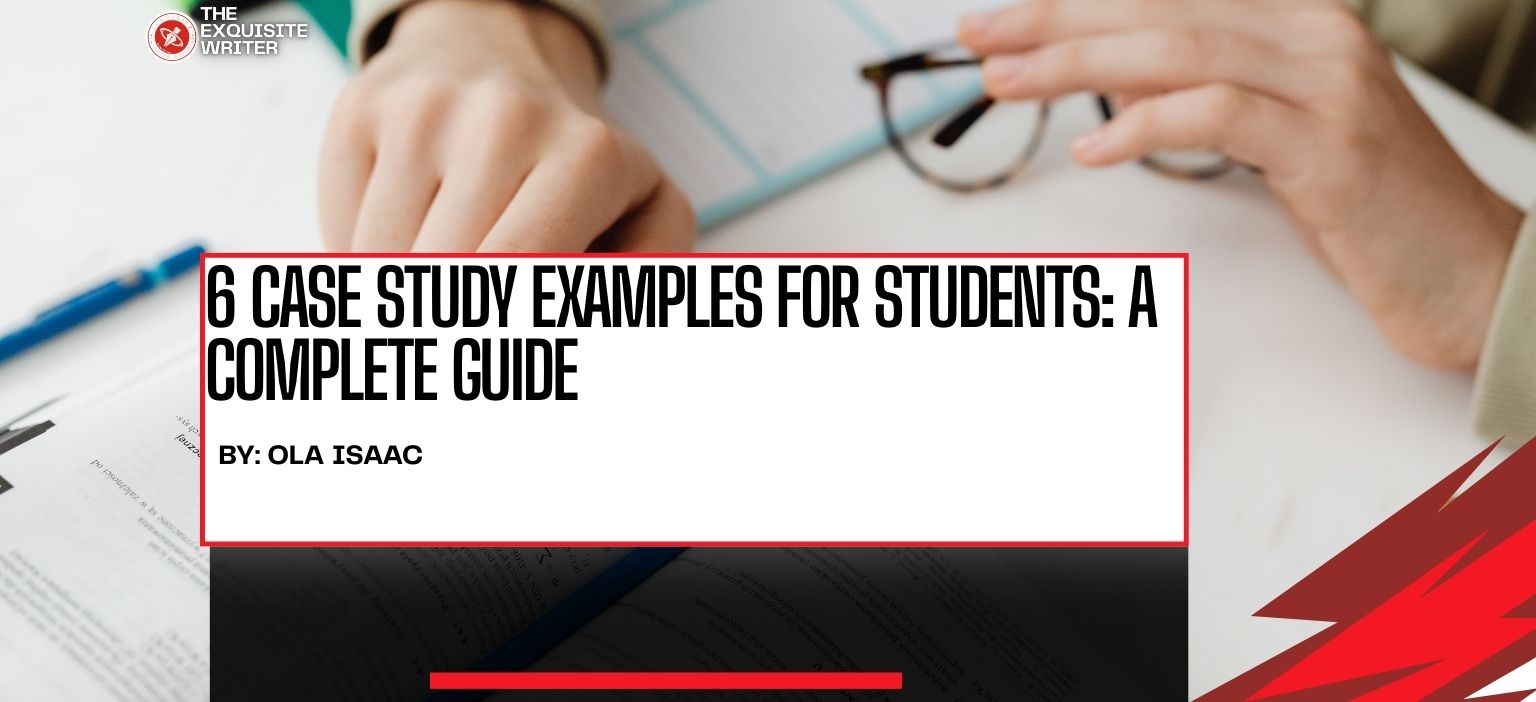Case studies are among the most effective learning, research, and professional development tools.
ResearchGate recent research confirmed that case studies are more effective than classroom discussions and textbook reading at promoting learning
In this article, we’ll examine case study examples for students.
Students offer a unique way to apply theory to real-world situations, sharpen critical thinking skills, and obtain a deeper understanding of complex concepts.
Therefore, whether you’re in medicine, business, social sciences, or engineering, studying these case study examples can help you learn how to analyze problems and present solutions.
Read on to explore case studies, why they matter, and case study examples for students across different disciplines!

What Is a Case Study?
A case study is a detailed examination of a person, organization, event, or issue. It combines qualitative and quantitative data to analyze real-life situations and illustrate how concepts work in practice.
Unlike general overviews, case studies focus intensely on the topic, often merging qualitative and quantitative data.
For students, case studies serve several purposes:
- They bridge theory and practice, indicating how concepts apply in real situations.
- They develop analytical and problem-solving skills.
- They prepare students for exams, research projects, and professional careers where case-based thinking is crucial.
Why Case Studies Are Important for Students
Case studies are more than assignments your lecturers hand out.
They’re powerful learning tools that prepare you for real-world problem-solving.
Unlike traditional memorization tasks, case studies demand analysis, critical thinking, and practical application — making them invaluable across fields.
Here’s why case studies play such an essential role in student learning:
1. Stimulate Active Learning
Students engage directly with real-world scenarios instead of passively absorbing information from lectures or textbooks.
Case studies push you to ask questions, evaluate varying perspectives, and apply theoretical frameworks to practical situations.
- Example: A business student analyzing Tesla’s growth strategy isn’t simply memorizing facts about the company. They actively explore how market trends, innovation, and leadership decisions interact.
2. Enhance Research Skills
University of Southern California stated that the purpose of a case analysis paper is to present a structured and logically organized format for analyzing the case situation.
Thus, writing or analyzing a case study forces students to obtain relevant data, evaluate sources, and synthesize findings into a highly structured format.
This process builds strong research and analytical skills, which are key to academic success and professional careers.
- Example: A medical student working on a case study about diabetes must review medical journals, patient histories, and treatment options before presenting a solution.
3. Develops Communication Skills
Case studies are simply about getting analysis and must be explained persuasively and clearly.
Students learn to present their findings in presentations, written reports, or group discussions. This enhances academic writing, teamwork, and public speaking skills.
- Example: Psychology students discussing the Stanford Prison Experiment often debate ethical implications, strengthening their ability to articulate complex ideas to different audiences.
4. Enhance Employability
Many industries—from marketing to law to consulting and healthcare—use case-based methods to solve problems.
Employers value graduates who can break down complex problems, think strategically, and propose actionable solutions.
Case study experience in school prepares students for these real-world demands.
- Example: During job interviews for consulting firms, candidates are often given “case interview” scenarios. Students familiar with academic case studies already have a strong foundation for tackling these challenges.
5. Develop Problem-Solving and Decision-Making Skills
Case studies simulate real-world challenges with no single “right” answer. Students should weigh options, consider risks, and justify their recommendations.
This trains them to be flexible, solution-oriented thinkers.
- Example: An engineering case study on bridge design might ask students to balance safety, cost, and sustainability, mirroring the trade-offs real engineers face.
6. Bridge Theory and Practice
Perhaps the most significant benefit is how case studies connect classroom knowledge to real-life applications.
They move abstract theories into tangible scenarios that students can question, analyze, and solve.
- Example: In education studies, comparing Finland’s school system with local methods allows students to apply theoretical learning models to practical policy discussions.
Related: 29 Best Free Writing Software (With Quick Review)
Case Study Examples for Students by Discipline
Case studies offer real-world scenarios that bridge the gap between theory and practice.
They help students move beyond textbook definitions and actively analyze strategy, decision-making, and outcomes in varying contexts.
Below are examples across key academic disciplines.
1. Business and Management Case Study Examples
Business case studies allow students to explore how companies compete, grow, and adapt to global challenges.
- Apple Inc.: Innovation and Product Strategy. Apple is often studied for its strength to balance sleek design, strong branding, and technological innovation.
Students can examine how Apple creates demand through product ecosystems (iPhone, iPad, Mac) while sustaining premium pricing strategies.
- Starbucks: Customer Loyalty Programs. Starbucks’ rewards system has become a model for building long-term customer relationships.
Students can analyze how mobile app integration, personalized offers, and community building keep customers returning.
- Tesla: Disrupting the Automotive Industry. Tesla showcases how sustainability and bold leadership can challenge long-established players in the auto industry.
This case challenges students to consider innovation, risk-taking, and scaling in a highly competitive sector.
Classroom application: Business students use these examples to discuss operations, strategy, entrepreneurship, and leadership.
They also practice evaluating risks, market positioning, and decision-making under pressure.
2. Marketing and Communications Case Study Examples
Marketing and communications case studies reveal how storytelling, branding, and consumer psychology shape company success.
- Nike’s “Just Do It” Campaign: This campaign shows the power of emotional branding, inspiring millions worldwide and embedding Nike’s identity into sports culture.
Students use this to evaluate how brand values connect with consumer aspirations.
- Coca-Cola vs. Pepsi Rivalry: One of the longest-running marketing rivalries in history, this case allows students to compare positioning strategies, advertising channels, and global branding tactics between similar products.
- Spotify’s Personalized Playlists: Spotify uses algorithms and customer data to create personalized playlists like “Discover Weekly.”
This case highlights how companies leverage technology to enhance customer loyalty and engagement.
- Benefit for students: These examples help marketing students understand consumer psychology, brand positioning, digital marketing strategies, and the importance of data-driven decision-making.
3. Medical and Health Sciences Case Study Examples
Medical and health science case studies are designed to prepare students for real clinical and public health challenges.
- The 1918 Spanish Flu Pandemic: This case highlights the importance of preparedness, rapid response, and international cooperation in global health.
Students can compare past and present health responses to better understand epidemiology.
- Patient with Type 2 Diabetes: A patient-centered case where students assess how lifestyle changes, diet, exercise, and medication adherence play a role in long-term disease management.
This teaches practical, everyday healthcare skills.
- COVID-19 Vaccine Development: A modern example of how international collaboration, funding, and scientific innovation can accelerate medical solutions.
Students can evaluate vaccine distribution’s ethical, social, and scientific dimensions.
In practice, Medical students gain critical thinking, diagnostic reasoning, and ethical decision-making skills.
These cases also prepare them for patient care and public health policy complexities.
4. Psychology and Social Sciences Case Study Examples
Psychology and social sciences often use case studies to explore how individuals and groups think, feel, and act.
These examples provide powerful insights into both human behavior and the responsibilities of researchers.
- Phineas Gage. This is one of the most famous cases in neuroscience. Gage survived a traumatic brain injury in 1848 when an iron rod pierced his skull.
His dramatic personality changes gave scientists early evidence of how brain regions influence behavior and decision-making.
- Stanford Prison Experiment. This was conducted in 1971 by Philip Zimbardo. This study examined how people adopt roles of authority or submission in a simulated prison environment.
The disturbing results highlighted ethical concerns in psychological research, particularly regarding consent and participant well-being.
- Bystander Effect Case Studies. Sparked by the 1964 Kitty Genovese case, these studies explore why people sometimes fail to help when others are present in emergencies.
They remain foundational in understanding social responsibility and group behavior.
Why useful: Psychology and social science students gain a deeper grasp of human behavior, social influence, research ethics, and theory application—skills that prepare them for careers in research, counseling, and public policy.
5. Education Case Study Examples
Education case studies highlight how teaching strategies, school systems, and learning environments shape student outcomes.
They are especially valuable for aspiring teachers, policymakers, and researchers.
- Finland’s Education Model. Finland consistently ranks high in global education due to its focus on teacher autonomy, minimal standardized testing, and student-centered learning.
This case invites students to analyze how cultural values and policies influence academic success.
- Digital Learning During COVID-19. The pandemic forced schools worldwide to adopt online platforms.
This case allows education students to assess challenges like the digital divide, student engagement, and long-term implications of e-learning.
- Montessori vs. Traditional Schooling. By comparing child-led Montessori education with structured traditional methods, students can evaluate how different teaching philosophies affect creativity, independence, and academic achievement.
For students: These examples help education majors design more effective learning systems, critically compare pedagogical approaches, and consider equity in education.
6. Engineering and Technology Case Study Examples
Engineering and technology case studies explore real-world challenges in design, safety, and innovation.
They prepare students to balance technical skills with ethical and societal considerations.
- Boeing 737 MAX Crisis: After two tragic crashes, investigations revealed flaws in software systems, design choices, and corporate oversight.
This case is a powerful example of how engineering errors and poor communication can lead to catastrophic failures.
- Google’s AI Development: Google has been at the forefront of artificial intelligence research, from search algorithms to generative AI.
Students can examine both the technological breakthroughs and the ethical questions around privacy, bias, and responsible AI use.
- Renewable Energy Projects: Case studies on wind farms, solar power plants, and hydroelectric systems highlight the technical, economic, and environmental aspects of shifting to sustainable energy.
Students learn how engineering can directly support climate goals.
Student takeaway: Engineering and technology students gain exposure to problem-solving under constraints, innovation ethics, safety protocols, and the impact of technology on society.
Engineering students learn problem-solving, design thinking, and the consequences of real-world decisions.
Quick Case Study Analysis Checklist
- Identify the main problem
- Gather relevant data
- Analyze causes and impacts
- Apply a theoretical framework
- Propose evidence-backed solutions
- Reflect on lessons learned
How Students Can Use Case Study Examples Effectively
Case studies are only useful when students know how to approach them critically.
Rather than reading passively, students should treat each case study as a training ground for real-world problem-solving.
Here’s how:
- Identify the problem clearly
Every case study revolves around a core issue, whether it’s a business facing declining sales, a patient with complex symptoms, or a policy with unintended consequences.
Students should learn to separate the main problem from side details.
A clear problem statement offers direction for the entire analysis.
- Analyze causes and impacts
Instead of stopping at “what happened,” students should dig deeper into why it happened and what effects it created.
For example, in a business case study, this could mean tracing financial losses back to poor strategy or external market shifts.
This step builds critical thinking and avoids superficial answers.
- Apply theoretical frameworks
Case studies aren’t just stories. They are opportunities to apply classroom knowledge.
Management students might use SWOT or Porter’s Five Forces, psychology students could apply cognitive or behavioral theories, and education majors might bring in pedagogical models.
Frameworks give structure to the analysis and show the ability to connect theory with practice.
- Propose solutions
After identifying the problem and analyzing causes, students should recommend practical, evidence-based solutions.
These can range from strategy adjustments in business, treatment plans in healthcare, or policy reforms in political science.
Strong solutions should consider feasibility, costs, and potential unintended consequences.
- Reflect on lessons learned
Finally, the real value of case studies comes from reflection. Students should ask: What does this case teach me?
How can I apply these insights in future academic work, internships, or careers?
Reflection ensures that the lessons don’t just stay on paper but influence future problem-solving and decision-making.
Frequently Asked Questions (FAQ)
1. Are case studies only for business students?
No. Case studies are used in medicine, psychology, engineering, law, education, and more.
2. How long should a student case study be?
Most academic case studies range from 800–2,000 words depending on the instructor’s guidelines.
3. What skills do case studies develop?
Critical thinking, decision-making, research, communication, and problem-solving.
4. Can beginners understand case studies easily?
Yes. Case studies are designed to be practical and relatable, even for new students.
Next: Content Calendar Example: Stay Consistent and Organized
Final Thoughts
Case studies are one of the most powerful tools for student learning.
They offer real-world context, help students think critically, and encourage practical application of academic theories.
By studying examples from business, healthcare, psychology, education, and technology, students can sharpen their skills and prepare for future challenges.
If you’re looking for inspiration, start with the case study examples listed above and try analyzing them with your insights.
With practice, you’ll not only improve academically but also build skills that employers value worldwide.
By practicing regularly and reviewing real case study examples, students build confidence and develop the analytical mindset needed for academic success and professional growth.
At The Exquisite Writer, we provide actionable educational resources to help you learn faster, write better, and stand out in your academic journey. Follow us for more student-friendly guides!

